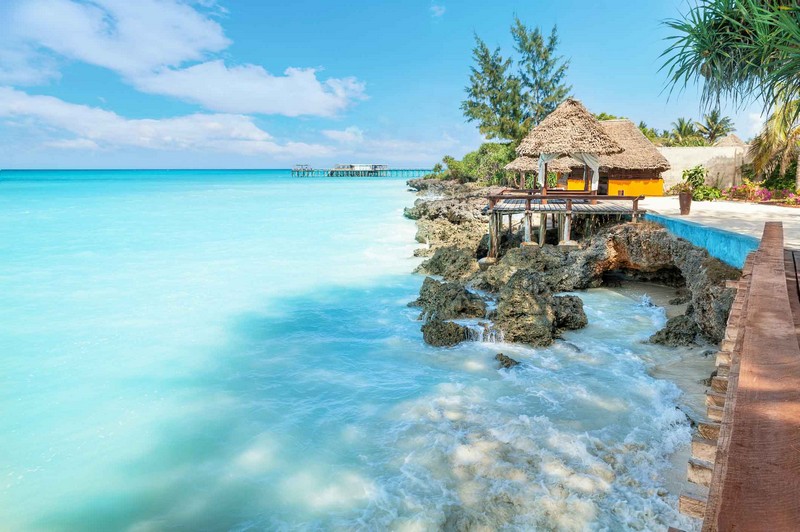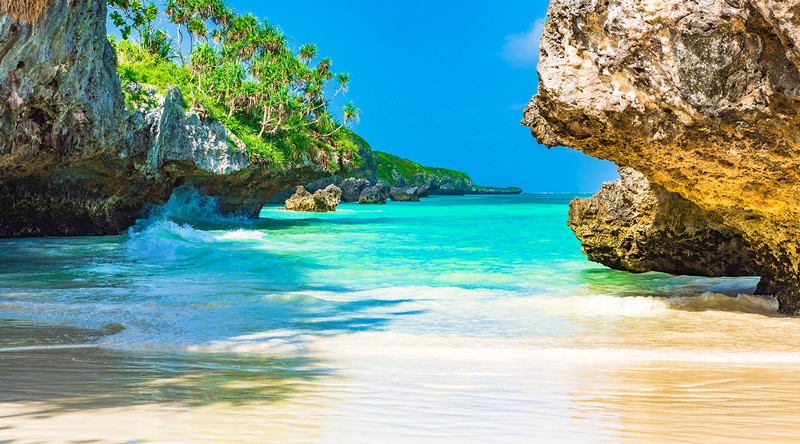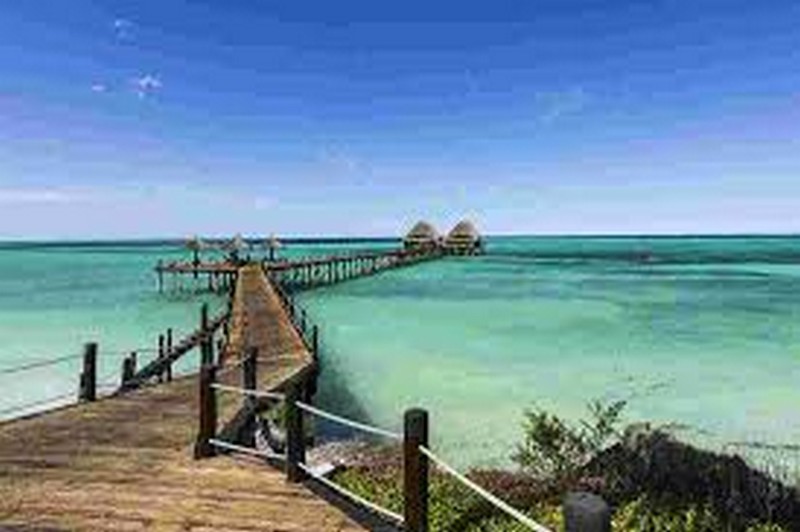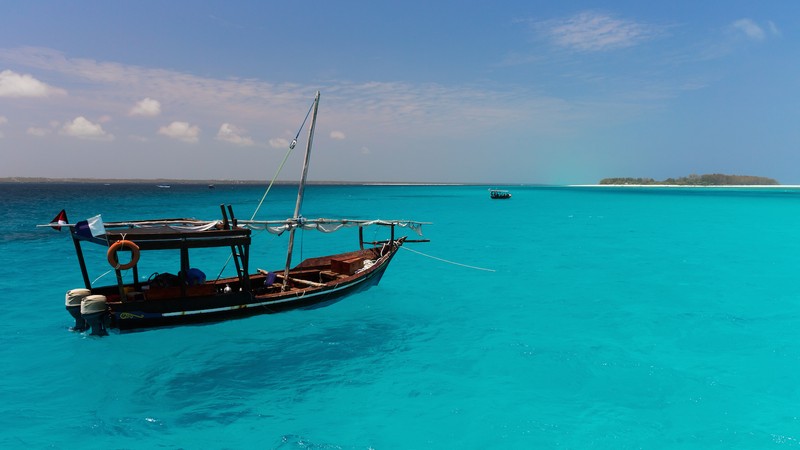(#wanderlusttips #Zanzibar #Tanzania) When hearing Tanzania, people often think of the nature reserves for wild animals or exploring the grand Kilimanjaro mountain, dubbed the roof of Africa. Tanzania is also home to Zanzibar, the most glamorous island in East Africa, covered in serene landscape and sporting a unique culture and architecture of indigenous peoples who have lived here for centuries.
[rpi]
A glimpse of history
After a 40-minute flight from Dar es Salaam, Tanzania’s largest city, we arrived in Zanzibar and began exploring the island with its white sand beaches, blue sea and the picturesque, colourful old quarter. Zanzibar is quite a special island. This semi-autonomous region of Tanzania has a separate system of government, including its own president, parliament and ministries. The name Tanzania is made up of Tanganyika (the mainland country) and Zanzibar and came to be when the two countries merged in 1964. Zanzibar refers to two islands, Unguja and Pemba. Pemba is a holiday destination and the capital Stone Town is located on Unguja. Most tourists only think of Ungujua when Zanzibar is mentioned.

Located on an important trade route in the Indian Ocean, Zanzibar was the gathering place for Arabs and Persians traders. Since the first century local spices and products have been traded here. The islands don’t have a lot of natural resources and minerals, but the soil here is rich and suitable to cultivate spices like cloves, nutmeg, cinnamon and black pepper. The reason for the island nickname: Spice islands.
The history of Zanzibar was tumultuous and this is reflected in the ancient architecture of Stone Town. From the 15th century, the island was under the control of the Portuguese, who lost it to the Oman during the 17th century. In the 19th century, the islands fell under British, German and Italian colonisation. What remains of the architecture in the old town is an intriguing mix of the various cultures that reigned here. The domes are shaped in the style of Persian architecture whereas many of the decorating patterns where introduced by the Indians. This cocktail makes the old town a unique and colourful cultural hub.
Stone Town – A vivid picture

We spent three days in Zanzibar and chose to stay at a hotel in Stone Town, a World Heritage Site recognised by UNESCO in 2000, which made it easy to tour the islands. We had heard that Zanzibar was a place to enjoy the slow life, so we decided to spend a day wandering through the old town. For the remaining two days, we rented a car to ride along the magnificent beaches of Zanzibar.
Stone Town is similar to Medina. It is made up of interlacing alleys creating a giant spider web. The highlights of the town are the old buildings constructed from coral stone, built in the 19th century. The ancient houses are impressive, with their intricately decorated doors and steps for pedestrians to rest. The mosques, Anglican and Roman Catholic churches, Oman’s ancient fortress, markets, schools and many extravagant mansions create a vivid picture of the town’s dynamic architecture.
The most famous place in Zanzibar’s Stone Town is the Palace of Wonders, a white palace built in 1883. Unfortunately, during our visit, the palace was being renovated but we still admired its unique, splendid architecture.
In the narrow alleys we would catch glimpses of Muslim women in colourful African attire. People on the islands always wear a friendly smile to greet visitors. Young Maasai men wearing traditional costumes were eager to take photos with us unlike people in other cities across Tanzania.
Visiting the slave market
In addition to the unique architecture, the old town also has attractions of great historical significance. One of them is the infamous slave market from the days of Oman rule, which today has been replaced by a Christian church.
Entering the church, we saw greetings written on the wall: “You are in the cathedral of Christ, which was once a slave market”. This church was built on the land where white men traded countless Africans like animals. The most special detail is the altar where many slaves suffered torture before being sold – a tradition used to select healthy slaves. The pillar at the entrance of the church is a wooden cross bearing the name of the liberation led by Livingstone, a British explorer, who appealed against these inhuman trades. The cross bearing his name was carved from a tree under which he once stood to call for the abolition of slave trade. In 1873 a law was passed to officially prohibit slave trade. Ever since the true dignity of black people has been recognised and protected on this beautiful island.

Similar to the monastery standing right next to the former Auschwitz concentration camp in Poland to silently remind people of the cruelty that humans have committed against their own kind, the Anglican Cathedral in Zanzibar is a lesson about the dark and painful past of mankind and times when people saw their own kind as merchandise to trade.
At twilight, we spent time watching the sunset from the coastal road of Mizingani eating a cooling ice cream cone. As the streetlights lit up, Forodhani Gardens started bustling and preparing to serve travellers, setting out exotic local specialties and street food to attract wanderers.
Coral stone paths
The next day, we got up early and rented motorcycles to explore the poetic side of Zanzibar. We visited an isolated village on Uzi, a small island located south of Zanzibar, which can only be reached when the low tide reveals the 5-kilometer coral stone path connecting the island to Unguja island.
Roads in Zanzibar are quite good and some were upgraded and expanded as the island became increasingly crowded. Zanzibar’s cars drive on the left side, so it took some time to get used to the road. The outskirts of the town are filled with immense green pepper and nutmeg farms and rows of ancient mango trees flanking the roadside. We could ride for kilometres under the shade of the mango trees, with tree trunks the width of two arm spans. Mangos are Zanzibar’s speciality and mainly consumed in mainland Tanzania, though many are served to visitors to the island.
After over two hours of driving, we arrived at the entrance of Uzi Island, surrounded by giant mangroves. A long rugged coral stone path, about 40 centimetres higher than the water level, appeared. Uzi Island is the second largest among the islands surrounding Unguja. The island is covered in green mango forests. We saw a lot of young children playing on the island. People on the island are poor. Besides agriculture, fishing, collecting seaweed, there is no mainstream tourism development on the island. We could not find a restaurant or hotel on the island. It seemed this was the destination for those who wanted to learn about the lives of those who live in isolation.

We had the opportunity to talk to some people on the island. They did not lack food or clothing, but wealth was a strange concept. The sound of prayers emanating from a small makeshift wooden mosque shattered the quiet atmosphere of this remote rural area. We left Uzi Island in a hurry on the coral stone path, before it disappeared in the high tide.
The impressive ‘The Rock’ restaurant
On our last day in Zanzibar, we travelled north where the iconic ‘The Rock’ has mesmerized visitors from around the world. We rented a small car to save time and getting a driver’s license on the island only costs 10 USD. Car rental on the island is fairly easy and we only needed to provide our Vietnamese license and passport numbers to complete the 30 minutes process.
Zanzibar increasingly attracts foreign tourists because of its open tourism policies, which have create favourable conditions for tourists to visit.
True to its name, The Rock restaurant is built on a large rock on Michanvi Ringwe beach, southeast of Zanzibar. ‘The Rock’ is extremely small with only 12 tables, so visitors must book in advance to secure a seat. At high tide water isolates the restaurant and visitors can only get there on a boat manned by a Maasai staff.
We did not have the special octopus salad and grilled lobster here, but wandered along the beach and bought some freshly caught seafood. Women on Zanzibar often collect seaweed or fish for octopus from coral rocks at low tide. They sell cheap seafood for guests on the spot, so they do not have to carry them to the markets, which are far. We visited a local home and asked them to make steamed seafood with pepper and enjoyed the dish on the windswept beach.
When we were in Zanzibar, we did not feel like we were in Africa. It seemed separate from the continent, geographically, but because of its white sandy beaches, the colourful old town, the people creating their traditional crafts and the delicious cuisine. May we meet again?
TIPS
1. VISA
Vietnamese people can apply for a visa at the border after arriving in Tanzania. Visas are issued upon landing in Dar es Salaam, Kilimanjaro, Mwanza or other destination ports. The Visa fee is 50 USD for a single entry, for a period of 3 months. Zanzibar is a semi-autonomous zone, so visas are often checked upon arrival on the island.
2. How to get to Zanzibar
– By plane: From the city of Dar es Salaam, you can buy a plane ticket to Zanzibar with Precision Air. You can buy tickets at https://www.precisionairtz.com. Flight duration is 40 minutes. If you’re lucky, you can get airfare as cheap as travelling by boat.
– By boat: From the city of Dar es Salaam, you can buy boat tickets to Stone Town. There are 4 trips per day, which take 2 hours 20 minutes. You can check schedules, fares and ticketing at: http://www.azammarine.com.
3. Transportation
– Motorcycle: You can rent motorcycles on a day-to-day rental basis. The longer you rent, the cheaper the price. The average price is 10 USD per day, excluding fuel. If you do not have an international driver’s license the car rental will obtain a permit from the traffic police for a price of 10 USD per vehicle.
– Cars: If you want to travel further, renting a car is a great choice in Zanzibar. A four-seater car rental costs 40 USD per day, excluding fuel. When renting a car, ask for a permit appropriate for the type of car you are renting to avoid trouble with traffic police, as each car type will require a different permit. The cost to obtain a permit is 10 USD per vehicle.
4. Accommodation
– Stone Town: Book a hotel room in the old town where the majority of luxury hotels are located with an average cost of 100 – 200 USD per double room. If you want to save money, you can book hotels located around the old town, costing 50 – 80 USD per room.
– Coastal resorts: Tourists often want to experience two places while in Zanzibar. Stone Town and relaxing at a seaside resort. The resorts in Zanzibar are concentrated in the Northeast and Northwest of the island, with many white sand beaches bordering the wonderful blue sea.
5. Food
– Most hotels include breakfast in the room rate. Some hotels also include main meals in the room rate.
– Beef bone soup, fresh seafood, grilled meats, mango, corn and watermelon are some of the specialties of Zanzibar. It is a largely Muslim country, so pork is prohibited.
6. Not-to-be-missed attractions in Zanzibar
– Prison Island is a 25-minute boat ride from Zanzibar. This historic island is where slaves and those with infectious diseases were once imprisoned. Today, this beautiful small island is a nature reserve where giant tortoises live next to the old ruins.
– Swimming on Zanzibar: The island has many beautiful beaches, a paradise of white sand and emerald tainted water. Some of Zanzibar’s most beautiful beaches include: Nungwi, Kendwa, Pongwe, Paje and Matemwe.
– Walk around Stone Town to see its unique architecture from the 15th – 19th century.
– Historic slave market.
– Darajani market with numerous craft products, representing the local culture.
– Enjoy seafood at The Rock restaurant.
– Join a tour to learn about the spices.
– Explore the historical architecture of the Palace of Wonder.
– Enjoy the sunset from the coastal path Mizingani.
– Explore Uzi island by motorcycle.
7. Books to bring on this journey
You should bring the book “Out of Africa” or see the film adaptation before you go. The book is based on the real life events of Danish baroness Karen Blixen. This Isak Dinesen romance could not exist without the amazing scenery of East Africa as a backdrop of a book set during colonial time. The most impressive imageries will overwhelm readers, as they get lost in descriptions of the majestic nature of some African countries and the poverty many Africans endured. Familiar landmarks are mentioned in the book, including the famous Serengeti lowland, Masai Mara National Reserve in Kenya, Ngorongoro Crater and Lake Manyara in Tanzania, which witnesses the annual migration of wild animals. These attractions give East Africa an unspoiled and poetic landscape. Many parts of Africa do not only possess rich nature as many people believe, but are also of many romantic love stories. The author skilfully chose this as the main theme for the book, to bring a story set in an iridescent and majestic continent to the world. This book and its film adaptation inspired me to explore the continent before it get increasingly industrialised by foreign projects.
Footsteps | Wanderlust Tips | Cinet

